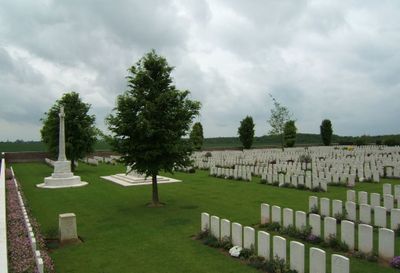David Alexander Sayer
From Our Contribution
 | |
| Personal Information | |
|---|---|
| Date of Birth | c1897 |
| Place of Birth | Leederville, Western Australia |
| Death | 10 Aug 1918 |
| Place of Death | Lihons, France |
| Age at Enlistment | 19 years, 6 months |
| Description |
5'6½" (1.69m) tall ; 145lbs 65.771 kg ; fresh complexion ; grey eyes ; brown hair |
| Occupation | Farm hand |
| Religion | Methodist |
| Address | Gosnells, Western Australia |
| Next of Kin | Father , Mr John Sayer |
| Military Information | |
| Reg Number | 7057 |
| Date of Enlistment | 25 Sep 1916 |
| Rank | Private |
| Unit/Formation | 11th Battalion, 23rd Reinforcement |
| Date of Embarkation | 23 Dec 1916 ‒ 16 Feb 1917 |
| Ship Embarked On | HMAT A35 Berrima Fremantle to Devonport |
| Fate |
WIA 20 Sep 1917 Polygon Wood KIA 10 Aug 1918 Lihons |
| Monument |
Gosnells War Memorial Gosnells Road Board Honour Roll Gosnells Primary School Honour Roll Gosnells Ward Honour Roll Australian War Memorial |
| Medals |
British War Medal Victory Medal |
Contents
[hide]Pre War
War Service
David entered Blackboy Hill camp on 25 Sep 1016 and on 26 Oct 1016 he was allocated to the 23rd reinforcement draft for the 11th Battalion, sailing with them to England aboard HMAT A35 Berrima. On arrival in England David was sent to the 3rd Training Battalion at Durrington to prepare for service on the Western front. On 8 Mar 1917, however, he was admitted to the Fargo Military Hospital where he received treatment until his release on 23 Mar 1917. On 22 May 1917 David proceeded overseas to France and after a few days in the Base Depot, he joined the 11th Battalion on 16 Jun 1917 in the field at Ribemont where they were rebuilding and training.
On 20 Sep 1917, the 11th Battalion led the advance to the first objective in the battle that became known as Polygon Wood. As they suffered no casualties on their later withdrawal, David's wound was caused during the advance or while they were holding their objective. Given it was a gunshot wound to both knees, it is likely to have occurred when he was erect, i.e. advancing. Treated by the 6th Field Ambulance and the 17th Casualty Clearing Station on 20 Sep 1917, he was placed on Ambulance Train No. 10 for Boulogne where he was admitted to the 2nd Canadian General Hospital at Outreau on the southern outskirts of that city on 21 Sep 1917.
Evacuated to England the following day on HMHS St Denis, he was admitted to the Ontario Military Hospital in Kent until 10 Oct 1917 when he was released to the 3rd Australian Auxiliary Hospital at Dartford. Granted furlough from 24 Oct - 7 Nov 1917, he was to report to the Training Depot at Codford. However, he was late getting back, and was charged with being AWOL from 3:30pm on 7 Nov 1917 until 6:00pm on 9 Nov 1917. After 2 days in custody awaiting his hearing, his case was heard on 12 Nov 1917, and he was awarded 2 days Field Punishment No. 2, (see notes) and had to forfeit 7 days pay.
On 5 Feb 1918 David was admitted to the Fovant Military Hospital for an unspecified operation, returning to duty on 6 Feb 1918, and on 28 Feb 1918, from the Overseas Training Brigade at Longbridge Deverill, he proceeded to Southampton and then overseas to France. He rejoined the 11th Battalion at the Caestre Siding as they entrained for Amiens as part of the redeployment of Australians southwards to stop the German advance on Amiens. On 3 May 1918 David reported to the 3rd Field Ambulance with severe diarrhoea, and on 5 May 1918 he was placed on Ambulance Train No. 32 for Boulogne where he was admitted to the 2nd Australian General Hospital. He was released to a convalescent depot on 11 May 1918, then to duty on 25 May 1918, and was sent to rejoin his battalion on 2 Jun 1918. However, enroute he was in need of medical treatment for an infection, and it wasn't until 12 Jul 1918 that he rejoined the 11th Battalion at La Kreule as they prepared to move into the front line at Strazeele.
During the Battel for Amiens, the 11th Battalion was tasked on the morning of 10 Aug 1918 with making an attack on the enemy's strong points to the left of Lihons. As they formed up an enemy plane acting as a spotter for its infantry marked their position, and they were soon on the receiving end of sustained machine gun fire which caused many casualties, especially amongst the officers and NCOs. After fierce fighting they reached their target positions, and soon after noon the enemy launched a counter attack. While this was driven off with the enemy sustaining heavy losses, they maintained a heavy rate of machine gun fire on the Australian positions for the rest of the day. Overnight the Australians won more ground and from 6:00am on 11 Aug 1918 the enemy made three more counter attacks in the fog before they were beaten off. The battle continued until early on 12 Aug 1918, with the 11th Battalion being relieved in the late afternoon. 11th Battalion casualties were 42 killed, 143 wounded and 7 missing.
Notes
Field punishment could be awarded by a court martial or a commanding officer for any offence committed on active service.
There were two categories of field punishment. Field punishment No. 2 consisted of heavy labouring duties. All offenders awarded field punishment would march with their unit, carry their arms and accoutrements, perform all their military duties as well as extra fatigue duties, and be treated as defaulters.

